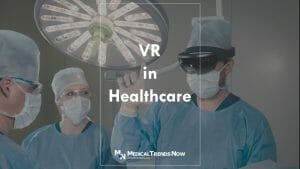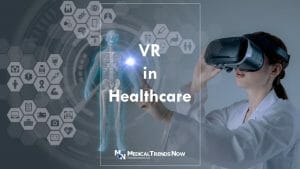Virtual Reality (VR) technology is rapidly changing how healthcare is delivered, providing numerous advantages over traditional methods. VR can revolutionize how healthcare professionals provide care and how patients receive it. The use of virtual reality in healthcare offers many benefits, such as improved diagnosis accuracy, enhanced training opportunities for medical staff, and better access to care in rural and remote areas. Additionally, VR technology can reduce costs associated with medical treatments by eliminating the need for physical travel or expensive equipment.
Virtual Reality in Healthcare Industry
The healthcare industry is increasingly turning to virtual reality technology to make medical treatments more effective and efficient. As technology advances, the use of virtual reality in healthcare is becoming more widespread.
With its immersive capabilities, VR can help doctors diagnose and treat patients better than traditional methods. By using VR simulations, physicians can practice difficult procedures before attempting them on real patients. Furthermore, medical students can gain hands-on experience with realistic scenarios without endangering anyone’s safety or well-being. In addition to teaching purposes, VR has prepared patients for surgery and recovery by allowing them to explore their environment virtually before they enter the operating room.
VR also offers a more comfortable way for health professionals to interact with their patients remotely. Telemedicine platforms allow doctors and other clinicians a way to communicate through a virtual space that simulates an in-person visit.

What are the Benefits of Virtual Reality in Healthcare?
Virtual Reality has become an increasingly popular technology in various industries, but there are many benefits to implementing it in healthcare. VR offers healthcare professionals and patients alike more opportunities for collaboration, treatment, and training.
VR can be used to bring together medical teams from across the world for virtual meetings or consultations. This allows for the efficient sharing of information and resources, leading to faster diagnosis and treatment. Furthermore, VR can also be used as a teaching tool that provides immersive experiences for medical students by allowing them to practice complex procedures without putting any real patients at risk.
For patients, VR offers an opportunity to explore their health issues through interactive gaming experiences that are both educational and entertaining. By allowing individuals to visualize their conditions in 3D scenarios with dynamic visuals, they become more engaged in their own treatment plans and more likely to follow through with their care plans.
What are the Drawbacks of Virtual Reality in Healthcare?
Virtual reality has seen a surge in popularity and use in healthcare, particularly with the emergence of telemedicine. However, while virtual reality has many potential benefits, there are also some drawbacks that must be considered.
One of VR technology’s primary drawbacks is its implementation cost. VR hardware and software can be expensive to purchase and maintain, making it difficult for certain healthcare establishments to afford necessary upgrades. Additionally, a virtual learning curve associated with using VR technology often necessitates additional training for staff members and may require significant time investments from administrators during implementation.
Furthermore, privacy concerns have been raised about patient data when it comes to virtual reality usage in healthcare applications as well. When sensitive medical information is stored digitally or transmitted over networks, it can leave patients vulnerable to security risks such as unauthorized access or cyber-attacks.

Challenges to the Adoption of Virtual Reality in Healthcare
The healthcare industry is on the cusp of a revolution with the emergence of virtual reality technology. With its ability to create immersive, three-dimensional learning environments, VR has the potential to transform how healthcare professionals are trained and how treatments are administered. While there is great promise in this new technology, several challenges must be addressed before it can be successfully adopted by health systems worldwide.
One challenge facing the adoption of virtual reality in healthcare is related to hardware cost and availability. Although advancements have been made to make consumer-grade headsets more affordable, many healthcare organizations lack the budget for costly professional-grade equipment needed for medical simulations and other training purposes. Additionally, a lack of experienced developers who specialize in creating medical simulations poses another obstacle to successful implementation within hospitals and clinics.
Data privacy concerns are a second barrier preventing the wider adoption of VR. With the increasing popularity of VR, concerns about data privacy have intensified. As a result, additional hurdles exist to adopting virtual reality in healthcare.

Methods of Deployment of Virtual Reality in Healthcare
Virtual Reality technology is quickly becoming a core tool in the healthcare industry. By providing an immersive, user-friendly interface, VR has the potential to revolutionize how medical professionals diagnose and treat patients. However, for doctors and nurses to get the most out of this revolutionary technology, it must first be deployed in a way that maximizes its capabilities. Here are some of the most popular methods for deploying virtual reality in healthcare settings:
One primary way VR is used in healthcare is through telemedicine and remote patient monitoring. With this method, medical professionals can use a specialized headset to communicate with their patients remotely while simultaneously accessing their patient’s health data from anywhere around the world. This opens up new possibilities for care delivery by allowing doctors to diagnose and monitor faraway patients more efficiently than ever before.

Clinical Use Cases of Virtual Reality in Healthcare
VR technology revolutionizes how healthcare professionals interact with patients. VR provides a unique opportunity for clinicians and doctors to gain critical insights into their patient’s health and create an immersive experience for diagnosis, treatment, and even rehabilitation.
In particular, VR can be used to improve the experience of medical procedures requiring long periods or significant amounts of data collection. For example, in gastroenterology, physicians can use VR headsets to view images captured by endoscopes as if they were looking through a scope directly inside the patient’s body. This allows them to make more accurate diagnoses faster than ever before. In addition, VR can be used in physical therapy settings to help patients undergoing rehabilitation visualize movements without being physically present at an appointment.

Future of VR in Healthcare, Pharmaceutical, and Medicine
The future of Virtual Reality in the healthcare industry is an exciting and rapidly evolving field. With its potential to improve patient care, reduce operational costs, and increase access to medical knowledge, VR is quickly becoming a game changer in the industry.
VR can be used in many ways within the healthcare system, from immersive training simulations for new practitioners to providing sophisticated telemedicine capabilities that allow doctors to diagnose and treat patients remotely. In addition, VR has been shown to provide psychological comfort during invasive procedures such as chemotherapy or radiation treatments where fear of the unknown may cause anxiety or stress. Furthermore, VR offers more interactive forms of therapy than traditional methods by allowing users with physical disabilities or mental health issues to practice exercises without having to leave home or be exposed publicly.

Pain Management and Virtual Reality
VR is becoming an increasingly popular method for helping to manage pain in healthcare settings. VR has the potential to improve quality of life and reduce reliance on traditional pain management techniques such as medication or invasive procedures. By immersing patients in a 3D environment, VR can help create a distraction from physical pain, allowing them to focus their attention away from their symptoms while still receiving the necessary treatment they need.
VR has many applications in healthcare, particularly when managing chronic or severe pain. In addition to providing relief through distraction, VR can also be used for cognitive-behavioral therapy and physiotherapy for recovery purposes. Additionally, some studies have shown that regular VR use can even reduce stress hormones and cortisol levels associated with chronic and acute pain.

Use VR in Medical Training
Virtual reality technology is becoming increasingly popular in the healthcare industry for medical training. VR has become a powerful tool for medical simulation, allowing doctors and nurses to gain experience in a safe and controlled virtual environment. It allows them to train without risking patient safety or wasting valuable time.
VR technology can be used in multiple aspects of healthcare training, including surgery simulations, diagnostics practice, patient treatments, and emergency response scenarios. In addition to providing a realistic learning environment with interactive elements like haptics and sound effects that stimulate the senses of sight, smell, touch, and sound, it also provides an intuitive interface with easy-to-use sensors that enable users to move freely within the system while interacting with objects as if they were real – without ever having to leave their seats.

Latest Healthcare Technologies for Hospitals Using Virtual Reality
As hospitals worldwide race to keep up with the ever-evolving healthcare landscape, they are turning to new technologies to help them stay ahead of the curve. One of the most promising advancements in recent years is virtual reality technology and its application in healthcare.
VR has become one of the most exciting new solutions for hospitals. It allows medical professionals to practice and refine their skills in a safe and controlled environment, where mistakes can be easily corrected without risk of harm to patients or staff. Additionally, VR can be used as an educational tool that allows students and clinicians alike to learn complex concepts quickly and accurately, which could result in better quality care for patients.
By using VR technology, hospitals can increase their efficiency while reducing training and medical error costs, allowing them to provide better care for their patients at lower costs.

Applications of Virtual Reality in Pharmaceutical
The advent of virtual reality technology has revolutionized the way healthcare is practiced. VR allows healthcare professionals to diagnose and treat patients innovatively, becoming an invaluable tool in the field of pharmaceuticals.
VR can be used to help medical students and pharmaceutical researchers gain a better understanding of human anatomy and diseases. For instance, 3D models created with VR technology allow students to explore the internal structure of organs without having to dissect cadavers or use other, more expensive methods. Pharmaceutical researchers have also begun using immersive simulations that replicate potential clinical trials to test new treatments without posing any risk to human subjects.
In addition, doctors are utilizing VR technology for patient diagnosis and treatment. For example, some surgeons use VR headsets during operations to access real-time information about surgical progress without looking away from their work.

Virtual Reality Therapy: The Use of VR in Rehabilitation
Virtual Reality has been making its way into healthcare settings, acting as a powerful tool for treatment and rehabilitation. VR has been especially helpful in the area of physical therapy and rehabilitation, with studies showing that it can improve motor learning and recovery. Virtual reality in healthcare is becoming increasingly popular due to the range of benefits it offers patients.
VR therapy involves using virtual worlds or simulations to help patients recover from various conditions, such as orthopedic injuries or neurological impairments. With a combination of sensors, interactive technology, visual feedback systems, and haptic devices, VR creates an immersive patient environment. This allows them to practice movements that would otherwise be difficult or impossible because of their condition. In addition to improving motor skills and aiding physical recovery, VR also helps reduce pain levels by providing a distraction from painful stimuli during treatment sessions.

VR Applications in Healthcare and Biomedical Industry
VR technology is transforming the healthcare and biomedical industries. As medical professionals become more familiar with this innovative technology, they are discovering various applications for it. VR can improve students’ medical education, train doctors in new procedures, simulate complex surgeries, and aid in patient rehabilitation.
The use of virtual reality in medicine has an array of benefits. It allows students to get hands-on experience without worrying about the consequences of making mistakes since it’s all happening in a virtual world. It also enables surgeons to practice specific techniques before attempting them on patients and provides helpful simulations that can be utilized during surgical training. Additionally, VR offers unique immersive environments that can help patients cope with pain or anxiety by distracting them from their treatments or symptoms.

VR Software Used in Healthcare
Virtual Reality is transforming the healthcare and biomedical industries. As medical professionals become more familiar with this innovative technology, they are discovering various applications for it. VR can be used to improve educational opportunities for medical students, train doctors in new procedures, simulate complex surgeries, and aid in patient rehabilitation.
The use of virtual reality in healthcare has an array of benefits. It allows students to get hands-on experience without worrying about the consequences of making mistakes since it’s all happening in a virtual world. It also enables surgeons to practice specific techniques before attempting them on patients and provides helpful simulations that can be utilized during surgical training. Additionally, VR offers unique immersive environments that can help patients cope with pain or anxiety by distracting them from their treatments or symptoms.
Virtual Reality in Diagnostics and Scanning
Virtual reality is revolutionizing the healthcare industry, with its applications already being used in diagnostics and scanning. In fact, this technology has been adopted by many medical practitioners worldwide to treat patients more efficiently and accurately.
Virtual reality in healthcare can assist doctors in making more accurate diagnoses by providing them with high-resolution 3D images of the patient’s body. This allows for a much better understanding of complex conditions and diseases, enabling them to make faster diagnosis decisions. Additionally, virtual reality can provide medical professionals with a more immersive experience during scans such as CT scans or MRI scans, allowing them to detect minute changes that may otherwise be missed. Furthermore, this technology also enables surgeons to practice operations on virtual models before performing actual surgery on patients.
Virtual Reality and Phobia
Virtual reality has been a revolutionary tool in healthcare and is now being used to help those with phobias. VR therapy has been proven effective in treating all types of phobias, from fear of heights or public speaking to even more severe anxieties like agoraphobia. Research shows that exposure therapy combined with virtual reality can help ease anxiety and provide relief for patients.
Through virtual simulations, patients can be exposed to their fears in a controlled environment where they feel safe and comfortable. While traditional exposure therapy requires physical stimuli, such as climbing steps or visiting a crowded store, VR technology allows for these experiences to happen virtually without any risk of actual harm being done. This opens up new opportunities for therapists and allows them to tailor the treatment plan specifically for each individual’s needs.
Final Thoughts: Benefits of Virtual Reality in Healthcare
In conclusion, the use of virtual reality in healthcare is a promising technology that has the potential to revolutionize the industry. It can improve patient care and safety, reduce costs, and increase access to care. There are numerous benefits to using virtual reality in healthcare, such as improved accuracy for diagnosis and treatment, enhanced doctor-patient interaction, improved training for medical professionals, and better data-gathering capabilities.
Virtual reality has immense potential to revolutionize healthcare. Its ability to provide realistic simulations, immersive experiences and cost-effective solutions make it invaluable in medical VR training, diagnosis, and treatment. With these advantages, there is no doubt that more and more applications of virtual reality in healthcare will be explored in the near future. The seemingly endless benefits are an exciting opportunity to take advantage of this technology to improve patient care.
Sources:
- Healthcare Market Augmented and Virtual Reality – GlobeNewsWire
- Virtual Reality Healthcare: Virtual Reality in the Healthcare Industry – Visualise
- VR Applications in the Healthcare Industry – Flatworld Solutions
- Virtual Instructor in Healthcare – Virtual Instructor Healthcare Jobs (with Salaries) 2022 – Indeed
- VR Tools in Healthcare: How Virtual Reality Is Transforming Healthcare – US Chamber of Commerce
- Virtual Reality Healthcare Market – Fortune Business Insights
- 5 Ways Medical Virtual Reality Is Already Changing Healthcare – Medical Futurist
- Medical applications of virtual reality – PubMed
- Therapeutic VR: Virtual Reality Therapy – Forbes
- VR Devices: How Virtual Reality Is Expanding Health Care – TIME
- VR help doctors better understand: What is the Importance of Virtual Reality to Doctors – Sciencing
- VR Surgery Process to Patients: Virtual reality system helps surgeons, reassures patients – Stanford University
- Wide Range of Exercises: The Effectiveness of Virtual Reality Exercise on Individual’s Physiological, Psychological and Rehabilitative Outcomes – National Library of Medicine
- VR Googles for Healthcare: VR Headsets For Use In The Medical Field – DPVR







